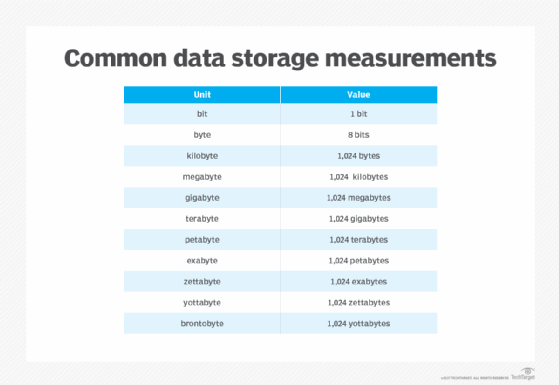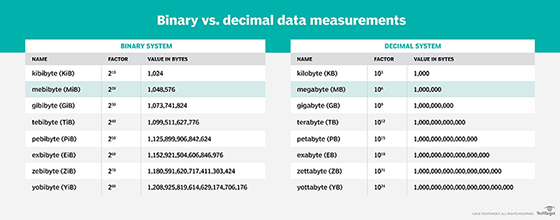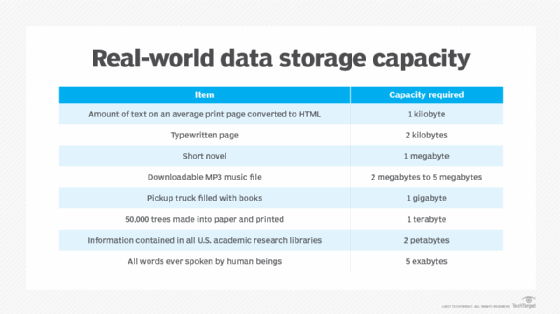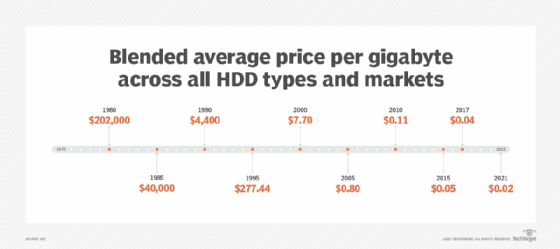gigabyte (GB)
What is a gigabyte (GB)?
A gigabyte (GB) -- pronounced with two hard Gs -- is a unit of data storage capacity that is roughly equivalent to 1 billion bytes. In decimal notation (base 10), a gigabyte is exactly 1 billion bytes. In binary notation (base 2), a gigabyte is equal to 230 bytes, or 1,073,741,824 bytes. Giga comes from a Greek word meaning giant. Werner Buchholz is credited with coining the term byte in 1956, while helping design IBM's 7030 Stretch, the first transistorized supercomputer.
A gigabyte has been a common unit of capacity measurement for data storage products since the mid-1980s. In recent years, terabytes (TB) have become a more common unit of storage capacity measurement, especially for hard disk drives (HDDs) and solid-state drives (SSDs).
Cloud providers and hardware vendors still often refer to storage capacity costs in terms of the amount per gigabyte, although that's been slowly transitioning to costs per terabyte. Today's HDDs and flash SSDs can easily store hundreds of gigabytes of data or even thousands, which is why the TB label has been steadily replacing GB in many instances.
What is a gigabyte in simple terms?
A gigabyte is a specific unit of data that's equal to about 1 billion bytes of data. The term gigabyte is typically used to describe the amount of stored data or the capacity of a storage device.
For example, an HDD might offer 500 GB of raw capacity but is currently storing only 200 GB of data. In addition to stored data, the gigabyte might also be used to refer to the amount of transferred data or storage throughput.

The gigabyte, like most data measurements, is based on the byte, which is equal to 8 bits of data. A gigabyte is equivalent to the following standard measurements:
- 1,000 megabytes (decimal) or 1,024 megabytes (binary);
- 1,000,000 kilobytes (decimal) or 1,048,576 kilobytes (binary); and
- 1,000,000,000 bytes (decimal) or 1,073,741,824 bytes (binary).
Data capacity measurements that are larger than a gigabyte include the following:
- A terabyte is equal to 1,000 gigabytes (decimal) or 1,024 gigabytes (binary).
- A petabyte is equal to 1,000,000 gigabytes (decimal) or 1,048,576 gigabytes (binary).
- An exabyte is equal to 1,000,000,000 gigabytes (decimal) or 1,073,741,824 gigabytes (binary).
Difference in how gigabytes are measured
The difference between the decimal amount and the binary amount has caused a fair amount of confusion among consumers, especially if they also come across such terms as kibibyte, mebibyte, gibibyte or tebibyte.
Computer, storage and network systems use two standards to measure the number of bytes in a gigabyte: base 10 and base 2. The base 10 definition of gigabyte uses the decimal system to show that 1 GB is equal to 109 bytes, or 1 billion bytes. Today, most storage manufacturers and consumers use the base 10 standard to define a gigabyte.
Computers and their operating systems often use the base 2, or binary, form of measurement, in which 1 GB equals 1,073,741,824 bytes. In this model, a gigabyte is sometimes referred to as a gibibyte, although not all vendors take this approach, thus the confusion. In the early days of storage, this wasn't a significant issue because the discrepancy between the base 10 and base 2 measurements wasn't substantial. However, the differences became more pronounced as vendors started manufacturing storage media with more capacity.

Because of the differences between the two standards, users might see discrepancies on their systems in how the amount of storage is reported. For example, a manufacturer might show the capacity of an HDD as 500 GB, but the computer reports the HDD's capacity as 466 GB. Fortunately, many systems now use GiB when specifically referring to gibibytes, helping to clarify the differences.
How long does it take to use 1 GB of data?
With today's data-intensive workloads, a gigabyte of data can be used up quickly. A single-layer digital video disk (DVD) can hold only 4.7 GB of data, and a double-layer disc can hold only 8.5 GB, a drop in the bucket compared to a 10 TB HDD. Even a typical laptop or desktop computer contains only 8 GB or 16 GB of RAM.
In more concrete terms, one gigabyte of data is equal to:
- 250 downloaded songs;
- 6,180 sent and received emails;
- 250 10-megapixel photos;
- 50,000 average emails with no attachments;
- 3,333 average emails with standard-sized attachments;
- 5 hours of standard-definition movies; or
- 353 one-minute YouTube videos.

What is a GB on a phone?
When purchasing smartphones, customers can often choose from multiple storage capacity options, which are typically based on available gigabytes. The more gigabytes, the higher the storage capacity -- and the higher the price tag.
For many customers, storage capacity is often one of the most important factors when choosing a phone. For example, Apple's iPhone 13 Pro offers four capacity options -- 128 GB, 256 GB, 512 GB and 1 TB -- while Samsung's Galaxy Z Flip3 5G offers only two options -- 128 GB or 256 GB. Most of today's phones use gigabyte as the measure of storage capacity, but as the iPhone 13 Pro indicates, it might be just a matter of time before gigabyte is supplanted by terabyte.
Regardless of which storage options that customers choose, they should be aware that available capacity is often less than the total capacity. For example, an iPhone might use between 11 GB and 14 GB of storage space for iOS and the preinstalled apps -- the exact amount depends on the model and settings. Software updates can also affect available capacity.
In addition, gigabyte measurements can play a role when smartphone customers select their cellular service plans. These days, many plans offer unlimited calling and texting but restrict the amount of data that can be transferred to or from the device. In fact, the data amount is often the prime differentiator between plans.
For instance, T-Mobile offers the Essentials, Magenta and Magenta MAX plans. The Essentials plan provides 50 GB of data, the Magenta plan provides 100 GB and the MAX plan offers unlimited data. In addition, the Magenta plan gets up to 5 GB of mobile hotspot data, and the MAX plan gets 40 GB of high-speed data and unlimited data at 3G speeds.
In today's market, gigabyte measures play an important role in choosing mobile devices and services, but it might not be long before the discussion revolves around terabytes rather than gigabytes. Until then, customers should pay close attention to the GB options available for their mobile devices.
Gigabyte history
The first gigabyte-capacity hard drive was IBM 3380, which was introduced in 1980. IBM 3380 packaged two 1.26 GB hard disk assemblies in a refrigerator-sized cabinet. Pricing ranged from $81,000 to $142,000, depending on the configuration.
When PCs were first introduced, HDDs were relatively small in terms of data capacity, and they were quite expensive. IBM Personal Computer XT, released in 1983, was the first PC with a built-in hard drive as a standard feature. It originally came with a 10 megabytes (MB) or 20 MB hard drive. In 1991, the first 1 GB drives became available with a price tag of nearly $3,000.
From there, hard drive capacity grew rapidly, with prices dropping just as fast. When Hitachi brought out the first 1 TB drive in 2007, the company noted that it took 35 years for HDDs to reach 1 GB and 14 years to get to 500 GB. The first 1 TB drives appeared only two years later.
Today, HDDs are available with 20 TB of storage, and SSDs can hold as much as 100 TB of storage.
Gigabyte vs. gigabit
A bit, which is short for binary digit, is the smallest unit of computer data. A bit has a single binary value that is either 0 or 1. Computers are generally designed to store data and execute instructions in bit multiples called bytes. In most computer systems, there are 8 bits in a byte and 8,589,934,592 bits in a gigabyte.
A byte -- and, by extension, a gigabyte -- typically describes data at rest, although it might also describe data being transferred between computer systems or to storage bandwidth or throughput. For example, computer memory and storage are often measured in bytes, such as a desktop with 16 GB of RAM and 750 GB of storage.
In many computer architectures, a byte is the smallest addressable unit of memory. For instance, an 820 MB hard drive holds 820 million bytes of data.
A bit -- and, by extension, a gigabit -- typically refers to data being transmitted over a network. For instance, gigabits are used to describe data transfer rates, such as network throughput and internet connection speeds, as in 10 gigabits per second or 10 Gigabit Ethernet.
Gigabyte-size storage options and pricing
Several types of storage media provide gigabyte range capacity, and those capacities can vary dramatically. Some of the most commonly used storage types in this range include HDDs, flash drives, memory cards, USB memory sticks, Blu-ray discs and DVDs.
Price per gigabyte varies among vendors and types of storage media. However, across all vendors and storage types, prices have been falling year over year. For example, the average price per gigabyte of an HDD in 2000 was nearly $8, according to IDC, but had dropped to 3.5 cents per gigabyte by 2017. Now, there are HDDs that offer storage for under 2 cents per gigabyte.
However, the year-over-year decline in the average price per gigabyte for HDDs has slowed significantly in recent years.

Since their introduction, flash drives have had a higher price per gigabyte than HDDs, but that's been changing in recent years as SSD capacities have increased and prices have dropped. The average price per gigabyte for SSDs has been steadily approaching parity with HDDs, although SSDs are still costlier, running 9 cents per gigabyte or more. That said, considerations such as durability, footprint, power consumption and ongoing maintenance should also be taken into account when evaluating the true total cost of ownership.







